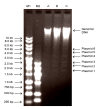Antibiotic resistance mechanisms of Myroides sp
- PMID: 26984839
- PMCID: PMC4794510
- DOI: 10.1631/jzus.B1500068
Antibiotic resistance mechanisms of Myroides sp
Abstract
Bacteria of the genus Myroides (Myroides spp.) are rare opportunistic pathogens. Myroides sp. infections have been reported mainly in China. Myroides sp. is highly resistant to most available antibiotics, but the resistance mechanisms are not fully elucidated. Current strain identification methods based on biochemical traits are unable to identify strains accurately at the species level. While 16S ribosomal RNA (rRNA) gene sequencing can accurately achieve this, it fails to give information on the status and mechanisms of antibiotic resistance, because the 16S rRNA sequence contains no information on resistance genes, resistance islands or enzymes. We hypothesized that obtaining the whole genome sequence of Myroides sp., using next generation sequencing methods, would help to clarify the mechanisms of pathogenesis and antibiotic resistance, and guide antibiotic selection to treat Myroides sp. infections. As Myroides sp. can survive in hospitals and the environment, there is a risk of nosocomial infections and pandemics. For better management of Myroides sp. infections, it is imperative to apply next generation sequencing technologies to clarify the antibiotic resistance mechanisms in these bacteria.
Keywords: 16S ribosomal RNA gene sequencing; Antibiotic resistance; Identification methods; Myroides sp.; Next generation sequencing.
Conflict of interest statement
This article does not contain any studies with human or animal subjects performed by any of the authors.
Figures


References
-
- Abrams AJ, Trees DL, Nicholas RA. Complete genome sequences of three Neisseria gonorrhoeae laboratory reference strains, determined using PacBio single-molecule real-time technology. Genome Announc. 2015;3(5):e01052–15. (Available from: http://dx.doi.org/10.1128/genomeA.01052-15) - DOI - PMC - PubMed
-
- An RF. A strain of Flavobacterium odoratum isolated from liver hydatid postoperative drainage liquid. Lab Med. 1992;(01):7. (in Chinese)
-
- Andreoni S. Isolation of Flavobacterium odoratumfrom human matter. Quad Sclavo Diagn. 1986;22(3):318–329. - PubMed
-
- Bachmeyer C, Entressengle H, Khosrotehrani K, et al. Cellulitis due to Myroides odoratimimus in a patient with alcoholic cirrhosis. Clin Exp Dermatol. 2007;33:97–98. (Available from: http://dx.doi.org/10.1111/j.1365-2230.2007.02590.x) - DOI - PubMed
-
- Benedetti P, Rassu M, Pavan G, et al. Septic shock, pneumonia, and soft tissue infection due to Myroides odoratimimus: report of a case and review of Myroides infections. Infection. 2011;39(2):161–165. (Available from: http://dx.doi.org/10.1007/s15010-010-0077-1) - DOI - PubMed
Publication types
MeSH terms
LinkOut - more resources
Full Text Sources
Other Literature Sources
Medical
Molecular Biology Databases
Research Materials
Miscellaneous

